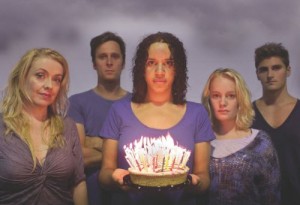Lyrebird | Focal Theatre & Tamarama Rock Surfers
- April 12th, 2012
- Posted in Reviews & Responses
- Write comment

We can’t help but be affected by our environment. In the early writings of settlers and convicts, the Australian bushland was often described as a harsh and unforgiving place, especially in contrast to the verdant European woodlands. We live on a very interesting island – one which has deserts and rainforests and snowy mountains and extinct volcanos – one which is sun scorched and covered in highly flammable material: trees.
Amelia Evans’ new play Lyrebird was nurtured under Jane Bodie’s guidance during the playwrights course at NIDA in 2010. Like other shows developed during that year: namely Jessica Bellamy’s Sprout and Maree Freeman’s Pictures of Bright Lights, it has been programmed by the Tamarama Rock Surfers and has been included on playwriting award shortlists. Previously it has enjoyed readings at NIDA and Parnassus Den. The list of thank yous and the level and quantity of industry names on that thank you list is extensive and glittering.
I like a lot about Amelia Evans’ writing. Last year I snuggled into a plaid blanket with Tom Hogan and Jess Bellamy outside the Seymour Centre to be swept away by Evans’ Cut Snake (directed by Paige Rattray). I like her writing. I like the emotional sensitivity of the characters – I like the plainness with how people speak – I like the moments of dangerous humour – I like the choices she asks the audience to make about their opinions.
I was in my late twenties when I saw my first lyrebird in the wild. I was bush walking at Minnamurra falls down the south coast (and inland a bit). My previous encounters of lyrebirds were via the 10 cent coin and a documentary by David Attenborough. Later it was the symbol of my work place (The Australian Film Commission which was made extinct in favour of the new Screen Australia branding). The lyrebird is a shy bird – ground dwelling – famous for it’s exotic dance displays and it’s mimicry. When I saw that bird for the first time, it felt like the natural equivalent of being a secret voyeur glimpsing a teenage girl singing into her hair brush.
Amelia Evan’s Lyrebird is not so shy. There is a robustness to this play’s premise and to the unpacking of the baggage of the characters, we don’t feel like they’re shy. There is nothing derivative about this text – there is no mimicry. So no glib parallel between text and the bird can be made.
Performances are well committed to. We love watching Lucy Miller as the insatiable June letting her emotions and desire tumble out of her. Sara Zwangobani is rock steady as Cate and it is Maeve MacGregor who lives brightly between the lines of dialogue and finds a playful rhythm to the text.
Direction by Jemma Gurney is fair and keeps out of the way of the writing. (Though I must admit the use of the upper stage section of the fitz should always be used sparingly in my opinion and some of the pace of the scenes are a little slow moving.)
But there are some missed opportunities in this text. Besides my feeling that the title of the play does not have much bearing on the content of the play – in tone or in theme, the premise is centred around the deep and difficult residue of a landscape which is destined to burn. And with necessary (essential) survivor guilt/sensations of loss, desire to make sense of causality, mourning the loss of past – the realisation which is missing the most, is that after fire, growth occurs. All of Australia’s flammable bushland is designed and destined to burn – and I’m not sure if all relationships are? Also there appears in the world of the play, that there may be animals returning/haunting the forest – before the vegetation. And I’m curious to know from my botanical expert friends, if that is true.
The question might be – how does the event of a major natural event, change the people who have experienced it? Would they have changed anyway? When did the transformation take place? Fire, as a classical symbol is about cleansing and purity. In the context of our land it is a destructive force, which brings new life: but not a change which is negative – but a change which is hopeful and renewed. I think there was an opportunity for this to be Jess’ story: about her opportunity to be/grow start anew, and with great hope and conviction, but she is faced with a difficult ultimatum which divides her, not renews her. But the story I understood, it was Cate’s story – and her decision to start again was precipitated by her jealousy and lack of trust and her guilt.
But, there is a tenderness and a humour in the writing which is compelling – and more room for growth, hope and regeneration.